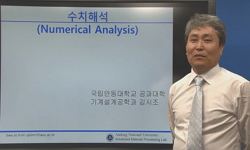In the present study, a variety of problems of conjugate heat transfer considering natural convection were analyzed. In chapter Ⅱ, a three-dimensional numerical study on flow pattern in winter along connecting passageway of a composite building was ...
http://chineseinput.net/에서 pinyin(병음)방식으로 중국어를 변환할 수 있습니다.
변환된 중국어를 복사하여 사용하시면 됩니다.
- 中文 을 입력하시려면 zhongwen을 입력하시고 space를누르시면됩니다.
- 北京 을 입력하시려면 beijing을 입력하시고 space를 누르시면 됩니다.
자연대류를 고려한 복합열전달의 수치해석 = Numerical analysis of conjugate heat-transfer considering natural convection
한글로보기부가정보
다국어 초록 (Multilingual Abstract)
In the present study, a variety of problems of conjugate heat transfer considering natural convection were analyzed. In chapter Ⅱ, a three-dimensional numerical study on flow pattern in winter along connecting passageway of a composite building was conducted using a commercial CFD package. The incompressible Navier-Stokes equation coupled was solved by using SIMPLE algorithm in order to find steady solutions. It was shown that a upward flow is generated inside the building in winter due to buoyancy effect and that the air inside connecting passageway flows form the shorter building to the taller one regardless of the slope of the passageway. Further, it was found that the magnitude of air velocity inside connecting passageway increases, although the variation in the magnitude of fluid velocity is not substantial. Lastly, it was shown that the maximum air velocity inside connecting passageway is less than the allowable limit for all the cases considered in this study.
In chapter Ⅲ, a conjugate heat-transfer problem in indirect moxibustion was analyzed by solving the problem of unsteady convective heat transfer coupled with conductive heat transfer. The interaction of a combustion-heated paper disk of moxa with the body and surrounding fluid was revealed by examining the body's unsteady temperature distributions. From the grid- and time step-independent solutions to the present conjugate heat-transfer problem, the effective stimulation periods for four widths of paper disk, along with the depths of the effective stimulation zones, were obtained. Further, it was found that the effective stimulation zone becomes larger and lasts longer for the wider paper disks, whereas the depth of the effective stimulation zone is saturated beyond a certain size. Lastly, the streamline pattern and the history of the spatially averaged heat-transfer coefficient, which is related to the convective heat transfer between the body and the surrounding fluid, were determined.
In chapter Ⅳ, a conjugate heat transfer problem of heating disk was investigated by solving the steady convective heat transfer problem coupled with the conduction heat transfer. The interaction of the heating disk with the body and surrounding fluid was examined by solving the Pennes bioheat equation coupled with the incompressible Navier-Stokes equations. From the present conjugate heat transfer analysis, the effect of blood perfusion rate and temperature of heating disk on the temperature distribution of the body was investigated. Lastly, the streamline pattern and the history of the spatially averaged heat-transfer coefficient, which is related to the convective heat transfer between the body and the surrounding fluid, were determined.
국문 초록 (Abstract)
본 연구에서는 자연대류를 고려한 복합 열전달의 다양한 문제에 대하여 선행 연구와 비교하고 정량적인 수치해석 결과를 도출하고자 한다. 세부적인 연구의 내용은 다음과 같이 구성되었다...
본 연구에서는 자연대류를 고려한 복합 열전달의 다양한 문제에 대하여 선행 연구와 비교하고 정량적인 수치해석 결과를 도출하고자 한다. 세부적인 연구의 내용은 다음과 같이 구성되었다.
Ⅱ장에서는 상용 수치해석 프로그램을 사용하여, 겨울철 복합 건축물 연결통로에서의 유동 형태에 대해 3차원 수치해석연구를 수행하였다. 정상상태의 비압축성 유동장의 해석을 위한 알고리즘으로 SIMPLE을 사용하였다. buoyancy 효과에 의해 겨울철 건축물의 내부 유동은 위로 향하며, 연결통로의 경사에 상관없이 내부의 공기의 흐름은 낮은 건물에서 높은 건물로 형성된다. 유체의 속도 크기에 대한 변화는 적지만, 연결통로 내부 공기의 속도 크기가 상승하는 것을 알 수 있었다. 마지막으로, 연결통로 내부 공기의 최대 속도는 본 연구에서 고려된 모든 경우에 대해서 허용되는 제한 조건보다 작은 것을 확인하였다.
Ⅲ장에서는 전도와 대류가 결합된 비정상 복합 열전달 문제를 해석함으로써, 간접 뜸의 복합 열전달 문제를 해석하였다. 신체의 비정상 온도 분포를 조사하여 신체 위의 연소 중인 쑥뜸의 종이 디스크와 주변 유체의 상호작용에 대해서 나타내었다. 쑥뜸의 복합 열전달 문제에 대해 격자와 시간간격에 무관한 해로부터 유효 자극 범위의 깊이에 따라 4개의 종이 디스크 너비에 대한 유효 자극 기간을 얻었다. 추가적으로, 종이 디스크의 너비가 넓어질수록 유효 자극 범위가 커지고 지속시간이 길어지지만, 유효 자극 범위의 깊이는 특정 너비 이상에서 수렴하는 것을 알 수 있다. 마지막으로, 신체와 주변 유체사이의 대류 열전달과 관련된 유선 형태와 공간적으로 평균한 열전달 계수를 알 수 있었다.
Ⅳ장에서는 전도와 결합된 정상 대류 열전달을 해석하기 위해 가열된 디스크의 복합 열전달 문제를 해석하였다. 비압축성 Navier-Stokes가 결합된 Pennes bioheat 방정식을 사용하여 신체 위의 가열된 디스크와 주변 유체와의 상호작용에 대해 조사하였다. 본 문제의 복합 열전달 해석으로부터, 신체의 온도분포에 대한 혈액관류율과 디스크의 온도에 대한 효과를 나타내었다. 마지막으로 신체와 주변 유체사이의 대류 열전달과 관련된 유선 형태와 공간적으로 평균되어진 열전달 계수를 확인하였다.
목차 (Table of Contents)
- 요 약 ⅰ
- 표 목 차 ⅲ
- 그림목차 ⅲ
- 기호설명 ⅵ
- Ⅰ. 서 론 1
- 요 약 ⅰ
- 표 목 차 ⅲ
- 그림목차 ⅲ
- 기호설명 ⅵ
- Ⅰ. 서 론 1
- Ⅱ. 복합 건축물 연결 통로에서의 기류형성에 관한 수치해석 2
- 1. 서론 2
- 2. 수치해석방법 3
- 3. 결과 및 고찰 8
- Ⅲ. 간접 뜸의 비정상 수치해석 13
- 1. 서론 13
- 2. 수치해석방법 15
- 3. 결과 및 고찰 17
- Ⅳ. 화상에 대한 수치해석 27
- 1. 서론 27
- 2. 수치해석방법 28
- 3. 결과 및 고찰 30
- Ⅴ. 결 론 37
- 참고문헌 41
- 영문요약(ABSTRACT) 45
- 감사의 글 47












